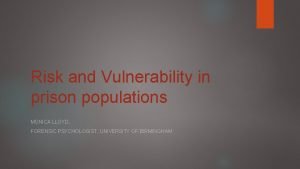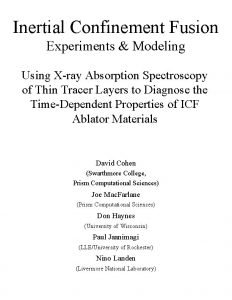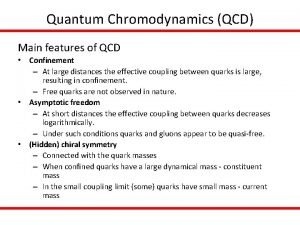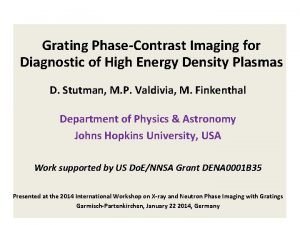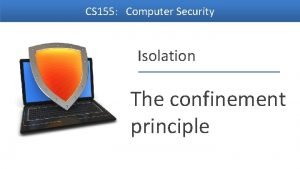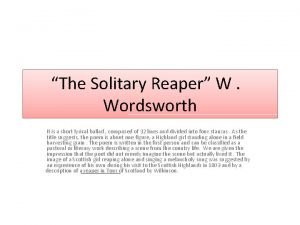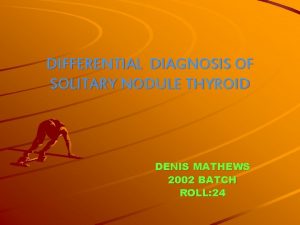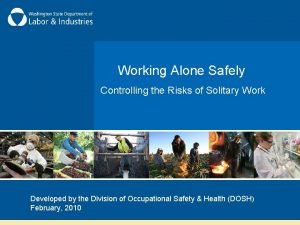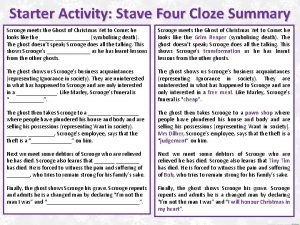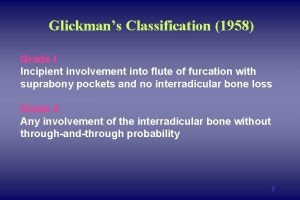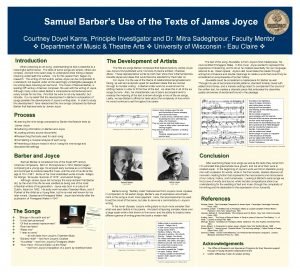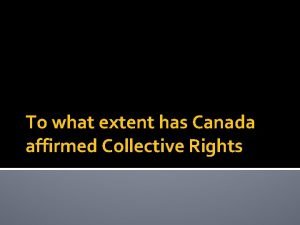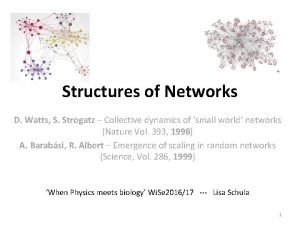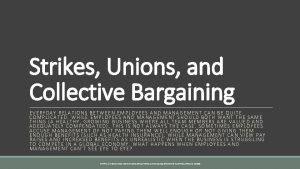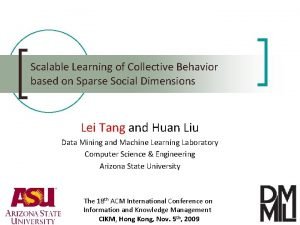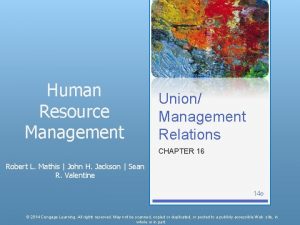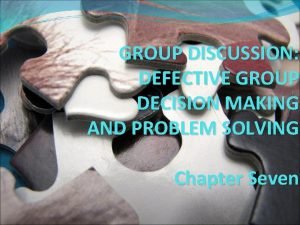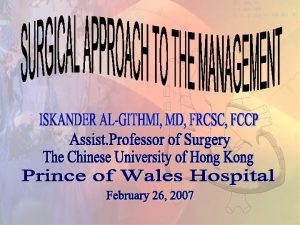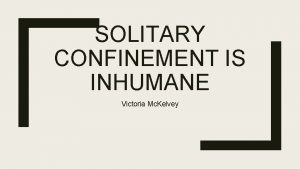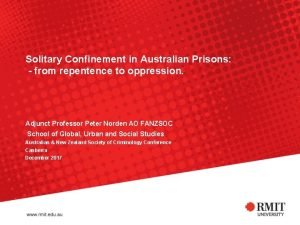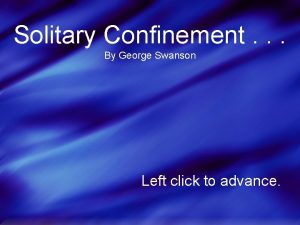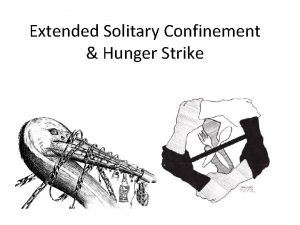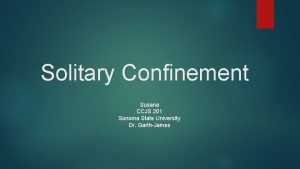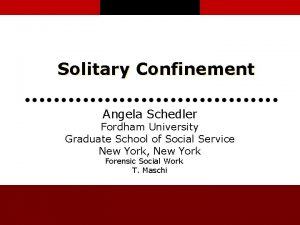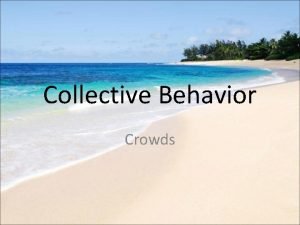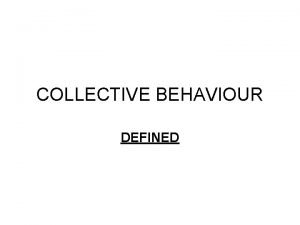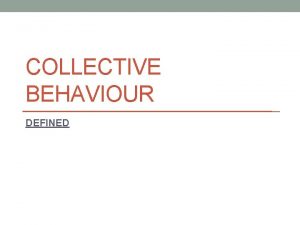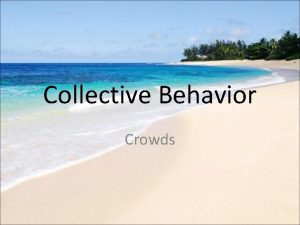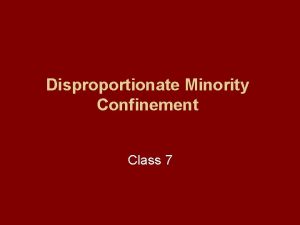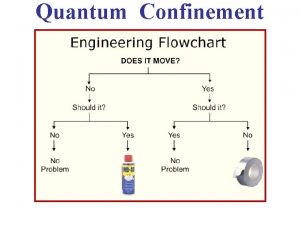SOLITARY CONFINEMENT From Social Death to Collective Resistance









































- Slides: 41

SOLITARY CONFINEMENT From Social Death to Collective Resistance

WHAT IS SOLITARY CONFINEMENT?





HOW MANY PEOPLE ARE HELD IN SOLITARY CONFINEMENT IN THE UNITED STATES TODAY?

Charles Samuels, Federal Bureau of Prisons Director: 'We do not practice solitary confinement. ’ Federal Supermax Prison, ADX Florence (410 solitary confinement units) Tommy Silverstein, in solitary confinement since 1983 (33 years)

Approximately 80, 000 people are in some form of “restrictive housing” in the US today Euphemisms for solitary confinement ■ Disciplinary segregation ■ Administrative segregation ■ Protective custody ■ Security Housing Units or Special Housing Units (SHU) ■ Intensive Management Units (IMU) ■ Restricted Housing Units (RHU) ■ Communication Management

WHO IS MOST LIKELY TO END UP IN SOLITARY?

Racial Disparities in the SHU ■ In the New York City jail system (2011 -13), African Americans were 2. 52 times more likely than whites to be put in solitary. Hispanics were 1. 65 times more likely. ■ In 2011, 85% of the prisoners in California’s Pelican Bay SHU were Latino, compared to only 41% of prisoners in the general prison population. ■ In Washington, D. C. (2014), 97% of men in administrative segregation — one type of solitary confinement — were black. ■ Mental illness and cognitive impairment is more likely to be interpreted as “bad” or “manipulative” behavior in black and brown prisoners. See, for example, Jonathan Metzl’s research on race and mental illness (The Protest Psychosis).


WHAT ARE THE TYPICAL EFFECTS OF SOLITARY CONFINEMENT?

SHU Syndrome Stuart Grassian and Craig Haney ■ Affective disorders such as anxiety, paranoia, uncontrollable rage, and depression ■ Cognitive disorders such as confusion, inability to focus, oversensitivity to stimuli, obsessive rumination, and memory loss ■ Perceptual disorders such as visual and acoustic hallucinations ■ Physical disorders such as headaches, lethargy, insomnia, digestive problems, heart palpitations, fainting spells, and bodily aches and pains ■ In extreme cases, psychotic breakdown, selfmutilation, and suicide

Five Omar Mualimm-ak “Sometimes, I smelled the paint on the wall, but more often, I just smelled myself, revolted by my own scent. “There was no touch… “After only a short time in solitary, I felt all of my senses begin to diminish. There was nothing to see but gray walls… “There was nothing to hear except empty, echoing voices from other parts of the prison. I was so lonely that I hallucinated words coming out of the wind. They sounded like whispers. “Even time had no meaning in the SHU. The lights were kept on for 24 hours. I often found myself wondering if an event I was recollecting had happened that morning or days before. I talked to myself. I began to get scared that the guards would come in and kill me and leave me hanging in the cell. Who would know if something happened to me? Just as I was invisible, so was the space I inhabited. “The very essence of life, I came to learn during those seemingly endless days, is human contact, and the affirmation of existence that comes with it. Losing that contact, you lose your sense of identity. You become nothing. ”

Robert King “When I walked out of Angola, I didn't realize how permanently the experience of solitary would mark me. Even now my sight is impaired. I find it very difficult to judge long distances – a result of living in such a small space. Emotionally, too, I've found it hard to move on. I talk about my 29 years in solitary as if it was the past, but the truth is it never leaves you. In some ways I am still there. ” - The Guardian, Aug. 27, 2010

Testimony from the SHU at Valley State Prison for Women Interviews by Cassandra Shaylor, 1998 ■ Angela Tucker: “It’s like living in a black hole. ” 52 women in the SHU at VSPW in 1998 40% Black, 21% Hispanic/Mexican, 5. 9% “Other” ■ Yvonne Smith, on routine strip searches in the SHU: “They don’t do this because of the ‘safety and security of the institution, ’ they do it for humiliation. Some of them really like it. There is nothing we can do between our cells and the shower, no way we can pick anything up. They’re with us, watching us the whole time. They are just tryin’ to break us down. ” ■ Claudia Johnson, on strip search and forced cell extraction: “It is about humiliation and total loss of dignity, and I don’t care what they call it. I call it rape. ”

Average Length of Time in Solitary in California Prisons: 6. 8 Years Over 1, 000 people have been isolated for over 10 years in California 78 people have been isolated for over 20 years

Social Death and Natal Alienation

WHY DO WE DO THIS TO PEOPLE?

Walnut Street Jail: The World’s First Penitentiary (1776 -1835)

Eastern State Penitentiary (18291971)




Benjamin Rush, “Enquiry into the Effects of Public Punishment” (1787) “I am so perfectly satisfied of the truth of this opinion that methinks I already hear the inhabitants of our villages and townships counting the years that shall complete the reformation of one of their citizens. I behold them running to meet him on the day of his deliverance. —His friends and family bathe his cheeks with tears of joy; and the universal shout of the neighbourhood is, ‘This our brother was lost and is found—was dead, and is alive. ’”

Charles Dickens, American Notes (1842) “Over the head and face of every prisoner who comes into this melancholy house, a black hood is drawn; and in this dark shroud, an emblem of the curtain dropped between him and the living world, he is led to the cell from which he never again comes forth, until his whole term of imprisonment has expired. . . He is a man buried alive; to be dug out in the slow round of years; and in the meantime dead to everything but torturing anxieties and horrible despair. ”


Cold War Sensory Deprivation Research After 6 days of sensory deprivation in Donald Hebb’s lab, 1956: “The whole room is undulating, swirling… The wall is waving all over the place -- a horrifying sight, as a matter of fact. . . The centre of that curtain over there —it just swirls downward, undulates and waves inside. . . I find it difficult to keep my eyes open for any length of time, the visual field is in such a state of chaos. . . Everything will settle down for a moment, then it will start to go all over the place. ”

Conference: The Power to Change Behavior (1961) James V. Bennett, director of the federal Bureau of Prisons from 1937 to 1964: “[W]e have a tremendous opportunity here to carry on some of the experimenting to which the various panelists have alluded… [W]e here in Washington are anxious to have you undertake some of these things. Do things perhaps on your own—undertake a little experiment of what you can do with the Muslims—undertake a little experiment with what you can do with some of the sociopath individuals… [Y]ou are thoughtful people with lots of opportunity to experiment--there’s lots of research to do--do it as individuals, do it as groups, and let us know the results. ”

Birth of the Supermax Prison ■ Politically active prisoners from across the US were relocated to Marion, including Leonard Peltier of AIM, Sekou Odinga of the Black Liberation Army, and Puerto Rican nationalist Oscar Lopez Rivera. ■ In 1973, the first Control Units were built at Marion. . § United States Penitentiary Marion was built in 1963 to replace Alcatraz. § The prison implemented experimental programs such as CARE (Control and Rehabilitation Effort) and Asklepieion, based on Cold War research on sensory deprivation and behavior modification. ■ In the words of former warden, Ralph Arons: “The purpose of the Marion Control Unit is to control revolutionary attitudes in the prison system and in the society at large. ” ■ In 1983, the entire prison was locked down in response to the murder of two prison guards. The lockdown remained in effect for 23 years, making Marion the first de facto supermax prison.

There are now at least 57 prisons across the US with supermax facilities

HOW CAN WE END THE PRACTICE OF EXTREME ISOLATION?

Madrid v Gomez (1995) ■ Judge Thelton Henderson: “Conditions in the SHU may well hover on the edge of what is humanly tolerable for those with normal resilience, particularly when endured for extended periods of time. They do not, however, violate exacting Eighth Amendment standards, except for the specific population subgroups identified in this opinion. ” (at 1280) ■ "Segregated detention is not cruel and unusual punishment per se, as long as the conditions of confinement are not foul, inhuman or totally without penological justification" (cited at 1262).

California Prison Hunger Strikes 2011, 2013 Over 30, 000 prisoners across California launched in the strike action in 2013. This is the largest hunger strike in state history.

Pelican Bay-SHU Short Corridor Collective Five Core Demands ■ to end group punishment for individual rule violations ■ to reform gang validation policies ■ to comply with the recommendations of a national commission on long-term solitary confinement ■ to provide adequate and healthy food ■ to expand rehabilitation and recreation programs





 Thomas silverstein
Thomas silverstein Solitary confinement effects
Solitary confinement effects Projet enseignement scientifique 1ère
Projet enseignement scientifique 1ère Inertial confinement fusion lasers
Inertial confinement fusion lasers Confinement qcd
Confinement qcd Inertial confinement
Inertial confinement Inertial confinement
Inertial confinement Confinement principle in computer system security
Confinement principle in computer system security Constant rate filtration and constant pressure filtration
Constant rate filtration and constant pressure filtration Air resistance
Air resistance Solitary independent play
Solitary independent play The solitary reaper
The solitary reaper The solitary reaper explanation stanza by stanza
The solitary reaper explanation stanza by stanza Rule of 12 in thyroid
Rule of 12 in thyroid Polychasial cyme inflorescence examples
Polychasial cyme inflorescence examples Solitary as an oyster pee paragraph
Solitary as an oyster pee paragraph Solitary work
Solitary work Vogelkopf syndrom
Vogelkopf syndrom Solitary as an oyster pee paragraph
Solitary as an oyster pee paragraph Tarnow and fletcher classification
Tarnow and fletcher classification Solitary hotel barber
Solitary hotel barber Somatic death and molecular death
Somatic death and molecular death Social thinking social influence social relations
Social thinking social influence social relations Social thinking social influence social relations
Social thinking social influence social relations Cupe 8443 collective agreement
Cupe 8443 collective agreement Collective intelligence example
Collective intelligence example Cyclic pitch vs collective pitch
Cyclic pitch vs collective pitch To what extent has canada affirmed collective rights?
To what extent has canada affirmed collective rights? Information et intelligence collective
Information et intelligence collective Niagara falls is the collective name for three waterfalls
Niagara falls is the collective name for three waterfalls Collective noun verb
Collective noun verb Collective dynamics of small world networks
Collective dynamics of small world networks Strikes unions and collective bargaining
Strikes unions and collective bargaining Collective behavior
Collective behavior Toll goods adalah
Toll goods adalah Collective security
Collective security Baset zarrug
Baset zarrug Role of collective bargaining
Role of collective bargaining International health collective
International health collective Paquet hygiène restauration collective
Paquet hygiène restauration collective Process of collective bargaining
Process of collective bargaining Collective inferential error
Collective inferential error

